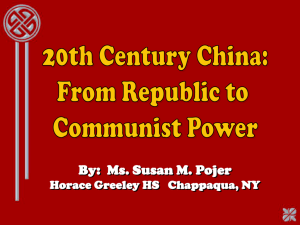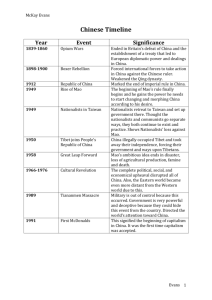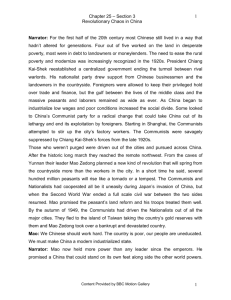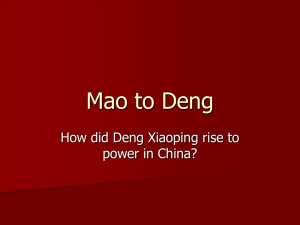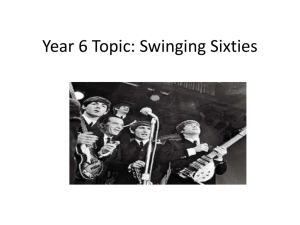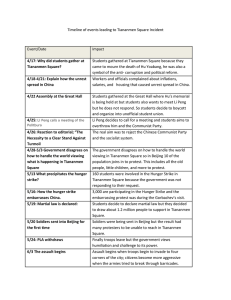Communism In China
advertisement
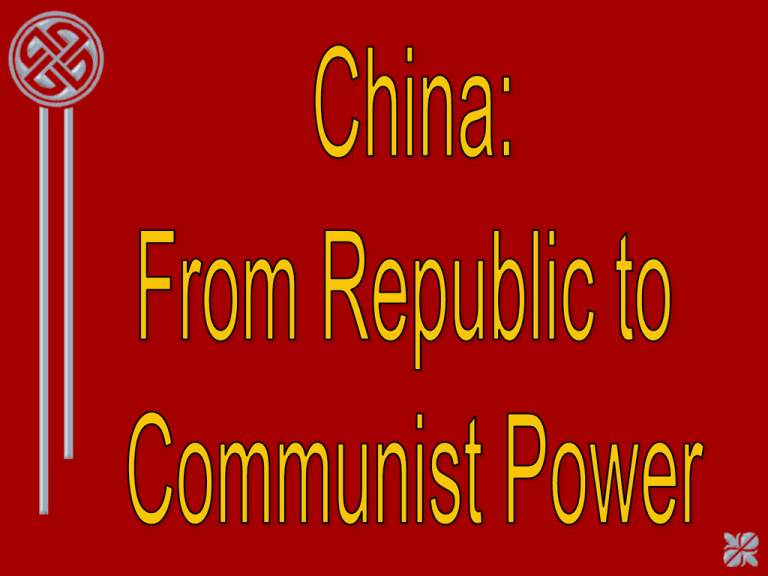
China before WWII • Had a revolution in 1911 • Got rid of ancient Chinese emperor system • Tired of being “carved up like a melon” – pushed around by European imperialist powers Dr. Sun Yat-sen (1866 – 1925) Led the Revolution of 1911 Chinese Warlords, 1920s • China was in chaos after the revolution • Feudal lords established control Yuan Shi-kai China in 1924 Mao Zedong • One of the groups competing for power were Communists, led by Mao • Focused on getting support of peasants Chiang Kai-shek Becomes President of Nationalist (Democratic) China, 1928 The new leader of the republic – tried to stop Mao’s rebellion THIS MEANS WAR!!! CIVIL WAR THAT IS!!! The Long March • Click here because my computer doesn’t want me to have a happy birthday! Communists travel 6,000 away from Nationalists- Journey lasts 1 year. 8,500 of 80,000 Communists survived Japanese Aggression, 1931 - 1945 Japan invaded China, along with East & Southeast Asia to carve for itself a “sphere of influence” • Communists & Nationalists ignore Japan and keep fighting each other. • What is wrong with this? • Eventually the Communists & Nationalists join together in order to rid China of Japan. • What do you think happens to this alliance following WWII? The Peoples’ Liberation Army, 1949 • Civil War began again, after the Japanese were expelled from China •Nationalist army outnumbered Communist •Truman Doctrine? •U.S. funded Nationalists The Communist Victory • So mad @ my computer right now! Taiwan: The Republic of China Chiang Kai-shek and his government was forced out of China to the tiny island of Taiwan. The People’s Republic of China Reasons for the Communists’ Success ► Mao won support of peasants – land ► Mao won support of women ► Mao’s army used guerilla war tactics ► Many saw the Nationalist government as corrupt (too much foreign influence) Communist China Under Mao ►Return China to a strong country ►Industrialized China ► Increased literacy ► Class privileges ended ► Rural Chinese received health care ► One-party dictatorship ► Denied people basic rights and freedoms Great Leap Forward, 1958 ► 5 year plan to increase agriculture and industry ► Built backyard furnaces to make iron ► Failed due to poor quality of products, no one working in fields – MASS FAMINE A Campaign Against the “FOUR OLDS” ► Old Thoughts ► Old Culture ► Old Customs ► Old Habits To Rebel Is Good! Smash the Old World. Establish a New World. Cultural Revolution ► Designed to reinstall a revolutionary spirit ► To forget Great Leap Forward’s failure ► Red Guards – students who attacked elders: professors, government officials, factory managers Red Guard With regard to the great teacher Chairman Mao, cherish the word 'Loyalty'. With regard to the great Mao Zedong Thought, vigorously stress the word 'Usefullness'. (1968) The reddest, reddest, red sun in our heart, Chairman Mao, and us together Workers, Farmers and Soldiers Art Academy collective, 1968 Mao’s Little Red Book Deng Xiaoping (19051997) De-Maoization “The 4 Modernizations” Progress in: ► Agriculture ► Industry ► Science ► Defense Class struggle was no longer the central focus! Gap Between Rich & Poor Deng: If you open a window, some flies naturally get in! Tiananmen Square, 1989 More democracy! Tiananmen Square, 1989 Student activist, Wang Dan, Beijing University Tiananmen Square, 1989 Democracy—Our Common Ideal! Tiananmen Square, 1989 The “Goddess of Democracy” Tiananmen Square, 1989 The Government Clamps Down Tiananmen Square, 1989 One Lone Man’s Protest Tiananmen Square, 1989 The Massacre: The People’s Army Moves In Tiananmen Square, 1989 The Massacre: A Human Body Crushed by an Army Tank Tiananmen Square, 1989 Student Leaders Are Arrested Propaganda Poster Go among the workers, peasants and soldiers, and into the thick of struggle! 1967-1972 Propaganda Poster Propaganda Poster Propaganda Poster Assignment *Page 539 *Copy the “Chinese Political Opponents” chart onto your notes. *Answer the skillbuilder questions. • Japan’s Invasion Japanese Soldiers March into Nanking December 9, 1937 Victims of the Japanese bombing of Shanghai. The Japanese Invasion, 1937 Beheadings Took Place in Public “Ping-Pong Diplomacy”: U. S. Players at Great Wall, 1971 Mao Meets President Nixon, 1972 Power Struggle Modernists 1976 Communist Traditionalists Zhou Enlai “The Gang of Four”: Jiang Qin, Chen Boda, Wang Hongwen, Yao Wenyuan Tiananmen Square, 1989 The Army Looks for Dissidents Tiananmen Square, 1989 Chinese Students Mourn the Dead Tiananmen Square, 1989 The Reestablishment of Order
